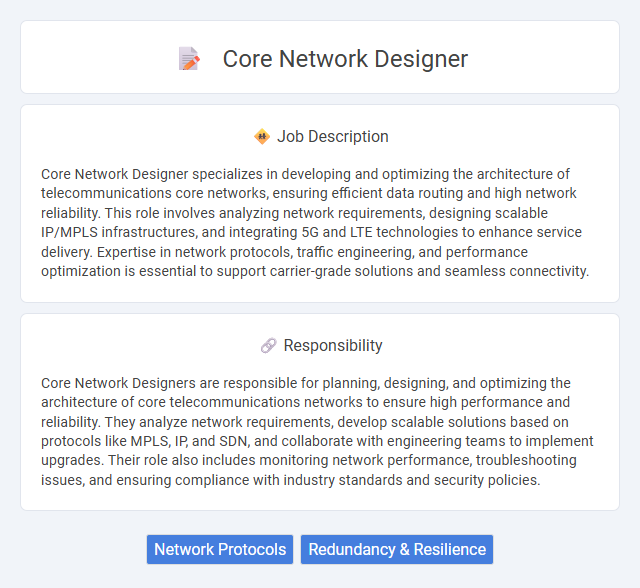
Core Network Designer specializes in developing and optimizing the architecture of telecommunications core networks, ensuring efficient data routing and high network reliability. This role involves analyzing network requirements, designing scalable IP/MPLS infrastructures, and integrating 5G and LTE technologies to enhance service delivery. Expertise in network protocols, traffic engineering, and performance optimization is essential to support carrier-grade solutions and seamless connectivity.
Individuals with strong analytical skills, problem-solving abilities, and a passion for telecommunications are likely to be well-suited for a Core Network Designer role. Those comfortable working with complex network architectures and keeping up with evolving technology trends may find this job engaging and rewarding. Candidates who prefer structured environments and collaborative teamwork could have a higher probability of success in this position.
Qualification
Core Network Designer roles require deep expertise in telecommunications protocols such as IP, MPLS, and LTE, alongside hands-on experience with 5G architecture. Strong proficiency in network planning tools, cloud-native technologies, and network function virtualization (NFV) is essential to optimize network performance and scalability. Certifications like Cisco CCNP, Juniper JNCIP, or equivalent vendor-specific credentials often validate the candidate's advanced technical skills.
Responsibility
Core Network Designers are responsible for planning, designing, and optimizing the architecture of core telecommunications networks to ensure high performance and reliability. They analyze network requirements, develop scalable solutions based on protocols like MPLS, IP, and SDN, and collaborate with engineering teams to implement upgrades. Their role also includes monitoring network performance, troubleshooting issues, and ensuring compliance with industry standards and security policies.
Benefit
A Core Network Designer likely provides significant benefits by enhancing the efficiency and reliability of telecommunications infrastructure through expert network planning and optimization. This role probably contributes to reducing downtime and improving data transmission quality, which are essential for maintaining strong service performance. Effective core network design may also lead to cost savings by minimizing unnecessary hardware investments and streamlining maintenance processes.
Challenge
The Core Network Designer role likely involves complex challenges related to architecting scalable and efficient network infrastructures that meet evolving technological demands. They may encounter difficulties in integrating new protocols and ensuring seamless interoperability across diverse network components. Managing latency, security vulnerabilities, and capacity planning could also present ongoing obstacles requiring innovative solutions.
Career Advancement
Core Network Designer roles offer significant career advancement opportunities through expertise in 5G, LTE, and emerging network architectures. Mastery of network protocols, optimization techniques, and cloud integration enhances employability in senior positions such as Network Architect or Technical Lead. Continuous learning in software-defined networking (SDN) and network function virtualization (NFV) drives progression toward strategic roles in telecommunications engineering.
Key Terms
Network Protocols
Core Network Designers specialize in developing and optimizing network architectures by implementing critical protocols such as MPLS, BGP, OSPF, and SIP to ensure seamless data routing and communication across carrier-grade networks. They analyze traffic patterns and utilize protocol-specific parameters to enhance network efficiency, scalability, and security in 4G/5G environments. Proficiency in standards like ITU-T, IEEE, and 3GPP is essential for maintaining robust core network infrastructure and supporting evolving telecommunications technologies.
Redundancy & Resilience
Core Network Designers specialize in creating and implementing network architectures that ensure high redundancy and resilience to minimize downtime and maintain continuous service availability. They develop failover strategies, design duplicate pathways, and integrate robust protocols to safeguard against hardware failures and cyber threats. Expertise in multi-layer network redundancy and dynamic load balancing is essential for optimizing performance and disaster recovery.
 kuljobs.com
kuljobs.com